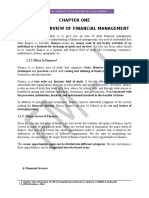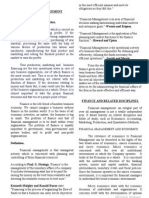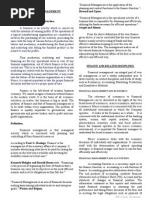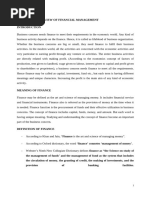1chapter1 FM1
1chapter1 FM1
Uploaded by
Abdii OlanaCopyright:
Available Formats
1chapter1 FM1
1chapter1 FM1
Uploaded by
Abdii OlanaOriginal Description:
Original Title
Copyright
Available Formats
Share this document
Did you find this document useful?
Is this content inappropriate?
Copyright:
Available Formats
1chapter1 FM1
1chapter1 FM1
Uploaded by
Abdii OlanaCopyright:
Available Formats
FINANCIAL ANAGEMENT-I
CHAPTER ONE
OVERVIEW OF FIACIAL MANGEMENT
1. Introduction
To have a good understanding of financial management, you need to understand first what
finance is. Literally, finance means the money used in day-to-day activities of an
individual or a business for exchange of goods and services. But here our focus rather should
be to consider finance as a separate and distinct field of study like accounting, economics,
mathematics, history, geography etc.
1.1. What Is Finance?
Finance is a distinct area of study that comprises facts, theories, concepts, principles,
techniques and practices related with raising and utilizing of funds (money) by individuals,
businesses, and governments.
Finance is a very wide and dynamic field of study. It directly affects the decisions of all
individuals and organizations that earn or raise money and spend or invest it. Therefore,
finance is also an area of study that deals with how, where, by whom, why, and through
what money is transferred among and between individuals, businesses, and governments. It
is concerned with the processes, institutions, markets, and instruments involved in the
transfer of funds.
In addition to principles and techniques, finance requires individual judgment of the person
making the financial decision. Hence, finance can also be defined as the art and science of
managing money.
1.1. Major Areas of Finance
Since the concepts and areas of finance are very broad, the academic discipline of finance can
be viewed as made of specialized areas. There are several ways to summarize the major areas
of finance. One way is to review the career opportunities under it. Another way is based on
the differences in the objectives of different organizations. For the sake of simplifying our
discussion, we summarize the major fields of finance based on career opportunities in
finance.
The career opportunities again can be divided into different categories. For our convenience,
these opportunities can be categorized into two broad areas.
i) Financial Services
This is a part of finance which involves personal career opportunities as a loan officer,
financial planner, stockbroker, real estate agent, and insurance broker. It is generally
Admas University Compiled BY MG (2019) Page 1
FINANCIAL ANAGEMENT-I
concerned with the design, development, and delivery of these financial services to
individuals, business organizations, and governments.
ii) Financial Management
Financial management is concerned with the financial decisions of a business firm. This firm
can be large or small, private or public, financial or non-financial, profit – seeking or not-for-
profit. It involves specific financial functions of the firm.
1.2. Meaning of Financial Management
Financial Management can be clearly defined by viewing it as a subject, a process, or a
function.
Financial management is one major area of study under finance. It deals with decisions
made by a business firm that affect its finances. Financial management is sometimes called
corporate finance, business finance, and managerial finance. These terms are used
interchangeably in this material.
Financial management can also be defined as a decision making process concerned with
planning for raising, and utilizing funds in a manner that achieves the goal of a firm.
There are many specified business functions performed by a business unit. These include
marketing, production, human resource management, and financial management. Financial
management is one of the important functions of a firm. It is a specified business function
that deals with the management of capital sources and uses of a firm.
1.2.1. Why Study Financial Management?
If you are approaching financial management for the first time, you might wonder why
students like you study the field of financial management and what career opportunities exist.
Many business decisions made by firms have financial implications. Accordingly, financial
management plays a significant role in the operation of the firm. People in all functional
areas of a firm need to understand the basics of financial management. Accountants,
information systems analysts, marketing personnel and people in operations, all need to be
equipped with the basic theories, concepts, techniques, and practices of managerial finance if
they have to make their jobs more efficient and achieve their goals. That is why the course
Financial Management is offered to students in the fields of accounting, management, business
administration, and management information systems.
Admas University Compiled BY MG (2019) Page 2
FINANCIAL ANAGEMENT-I
If you develop the necessary training and skills in financial management, you have career
opportunities in a good deal of positions as a financial analyst, capital budgeting, project
finance, cash, and credit manager, financial manager, banker, financial consultant, and even as
a general manager. The author hopes you will appreciate the importance of financial
management as you learn it more.
1.3. Finance and related fields
Though finance had ceded itself from economics, it is not totally an independent field of study.
It is an integral part of the firm’s overall management. Finance heavily draws theories,
concepts, and techniques from related disciplines such as economics, accounting, marketing,
operations, mathematics, statistics, and computer science. Among these disciplines, the field of
finance is closely related to economics and accounting.
1.3.1. Finance versus Economics
Finance and economics are closely related in many aspects.
First, economics is the mother field of finance.
Second, the economic environment within which a firm operates influences the decisions
of a financial manger. A financial manger must understand the interrelationships between
the various sectors of the economy. He must also understand such economic variables as a
gross domestic product, unemployment, inflation, interests, and taxes in making financial
decisions.
Financial managers must also be able to use the structure of decision-making provided
by economics. They must use economic theories as guidelines for their efficient
financial decision making. These theories include pricing theory through the
relationships between demand and supply, return analysis, profit maximization
strategies, and marginal analysis.
The last one, particularly, is the primary economic principle used in financial
management.
Basic Differences between Finance and Economics
i) Finance is less concerned with theory than is economics. Finance is basically concerned
with the application of theories and principles.
ii) Finance deals with an individual firm; but economics deals with the industry and the
overall level of the economic activity.
1.3.2. Finance versus Accounting
Admas University Compiled BY MG (2019) Page 3
FINANCIAL ANAGEMENT-I
Accounting provides financial information through financial statements. Therefore, these two
fields are closely linked as accounting is an important input for financial decision-
making. Besides, the accounting and finance functions generally overlap; and usually it is
difficult to distinguish them. In many situations, the accounting and finance activities are
within the control of the financial manager of a firm.
Basic Differences between Finance and Accounting
i) Treatment of income: - in accounting income measurement is on accrual basis. Under this
method revenues are recognized as earned and expenses as incurred. In finance,
however, the cash method is employed to recognize the revenue and expenses.
ii) Decision-making: - the primary function of accounting is to gather and present financial
data. Finance, on the other hand, is primarily concerned with financial planning,
controlling and decision-making. The financial manger evaluates the financial
statements provided by the accountant by applying additional data and then makes
decisions accordingly.
iii) Accounting is highly governed by generally accepted accounting principles.
1.4. Scope of Financial Management (Traditional Vs Modern Views)
The scope of financial management refers to the range or extent of matters being dealt with in
financial management.
Traditionally, financial management was viewed as a field of study limited to only raising of
money. Under the traditional approach, the scope and role of financial management was
considered in a very narrow sense of procurement of funds from external sources. The subject of
finance was limited to the discussion of only financial institutions, financial instruments, and
the legal and accounting relationships between a firm and its external sources of funds. Internal
financial decision makings as cash and credit management, inventory control, capital budgeting
were ignored. Simply stating, the old approach treated financial management in a narrow sense
and the financial manager as a less important person in the overall corporate management.
However, the modern or contemporary approach views financial management in a broad sense.
Corporate finance is defined much more broadly to include any business decisions made by a
firm that affect its finance. According to the modern approach, financial management provides
a conceptual and analytical framework for the three major financial decision making functions
of a firm. Accordingly, the scope of managerial finance involves the solution to investing,
financing, and dividend policy problems of a firm. Besides, unlike the old approach, here, the
Admas University Compiled BY MG (2019) Page 4
FINANCIAL ANAGEMENT-I
financial manager’s role includes both acquiring of funds from external sources and allocating
of the funds efficiently within the firm thereby making internal decisions.
The increased globalization of business has expanded the scope of financial management further
to include financial decisions pertaining to the international financial environment.
1.5. The Functions of Financial Management
This refers to the special activities or purposes of financial management. The functions of
financial management are planning for acquiring and utilizing funds by a firm as well as
distributing funds to the owners in ways that achieve goal of the firm. In general, the functions
of financial management include three major decisions a firm must make. These are:
Investment decisions Financing decisions Dividend decisions
1.5.1. Investment Decisions
They deal with allocation of the firm’s scarce financial resources among competing uses. These
decisions are concerned with the management of assets by allocating and utilizing funds within
the firm. Specifically, the investment decisions include:
i) Determining the asset mix or composition: - determining the total amount of the
firm’s finance to be invested in current and fixed assets.
ii) Determining the asset type: - determining which specific assets to maintain within the
categories of current and fixed assets.
iii) Managing the asset structure, i.e., maintaining the composition of current and fixed
assets and the type of specific assets under each category.
The investment decisions of a firm also involve working capital management and capital
budgeting decisions. The former refers to those decisions of a firm affecting its current assets
and short – term liabilities. The later, on the other hand, involves long – term investment
decisions like acquisition, modification, and replacement of fixed assets.
Generally, the investment decisions of a firm deal with the left side of the basic accounting
equation: A = L + OE (Assets = Liabilities + Owners’ Equity).
1.5.2. Financing Decisions
The financing decisions deal with the financing of the firm’s investments, i.e., decisions whether
the firm should use equity or debt funds in order to finance its assets. They are also concerned
with determining the most appropriate composition of short – term and long – term financing.
Admas University Compiled BY MG (2019) Page 5
FINANCIAL ANAGEMENT-I
In simple terms, the financing decisions deal with determining the best financing mix or capital
structure of the firm.
The financing decisions of a firm are generally concerned with the right side of the basic
accounting equation.
1.5.3. Dividend Decisions
The dividend decisions address the question how much of the cash a firm generates from
operations should be distributed to owners in the form of dividends and how much should be
retained by the business for further expansion. There are tradeoffs on the dividend policy of a
firm. On the one hand, paying out more dividends will make the firm to be perceived strong and
healthy by investors; on the other hand, it will affect the future growth of the firm. So the
dividend decision of a firm should be analyzed in relation to its financing decisions.
1.6. The Goal Of A Firm In Financial Management
1.6.1. The Need for a Goal and Characteristics of a Good Goal
A goal or an objective provides a framework for the decision maker. In most cases, the goal is
stated in terms of maximizing or minimizing some variable. A goal, therefore, is an explicit
operational guide or decision rule for the decision maker.
Although it is very difficult, a firm should be able to have a specific goal for the following two
basic reasons.
1. If a goal is not chosen, there is no way to select among alternative decision criteria. Without
an objective to achieve, there would be a number of approaches to select from available
decision rules.
2. If multiple goals are chosen, it is hardly possible to prioritize the decision criteria; and the
firm might end up achieving none of them
If a firm cannot choose its right goal, it can suffer severe consequences even to the extent of
going out of business. In fact, selecting the right goal is not such a simple task; but a good
objective has the following characteristics.
1. It is clear and unambiguous – a clear goal will lead to decision criteria that do not vary
from case to case and from person to person.
2. It provides a clear and timely measure to evaluate the success or failure of decisions.
3. There should be some means to measure the objective.
4. It does not affect the specific benefits of a firm.
5. It does not affect the welfare of the society.
6. It is based on long-term success of the firm.
Even though there are many alternative decision rules, in the sections that follow, we describe
and evaluate the decision criteria for financial management which are widely discussed in many
finance literature.
Admas University Compiled BY MG (2019) Page 6
FINANCIAL ANAGEMENT-I
1.6.2. Profit Maximization As A Decision Rule
16.2.1. Meaning of Profit Maximization
Profit maximization is a function of maximizing revenue and /or minimizing costs. If a firm is
able to maximize its revenues for a given level of costs or minimizing costs for a given level of
revenues, it is considered to be efficient.
Profit maximization focuses on the total amount of benefits of any courses of action. This
decision rule as applied to financial management implies that the functions of managerial
finance should be oriented to making of money. Under the profit maximization decision
criteria, actions that increase profit of a firm should be undertaken; and actions that
decrease profit should be rejected. Similarly, given alternative courses of actions, decisions
would be made in favor of the one with the highest expected profits.
Profit maximization, though widely professed, should not be used as a good goal of a firm in
financial management. This is because it fails to meet many of the characteristics of a good
goal.
16.2.2. Limitations of Profit Maximization
1. Ambiguity. The term profit or income is vague and ambiguous concept. Different people
understand profit in different several ways.
There are many different economic and accounting definitions of profit, each open to its
own set of interpretations. Even in accounting profit might refer to short-term or long-
term profit, total profit or profit on a per share basis (earnings per share), and before or
after text profit.
Then, the question or the problem would be which profit is to be maximized? Maximizing
one may lead to minimizing the other.
Furthermore, problems related to inflation and international currency transactions
complicate the issue of profit maximization.
2. Cash flows. The profit a firm has reported does not represent the cash flows to the
business. Firms reporting a very high total profit or earnings per share might face
difficulty of paying cash dividends to stockholders.
3. Timing of Benefits. The profit maximization criterion ignores the differences in
the time pattern of benefits received from investment proposals. This criterion does not
consider the distinction between returns (benefits) received in different time periods and
treats all benefits as equally valuable irrespective of the time pattern differences in
benefits. In other words, the profit maximization ignores the time value of money, i.e.,
Admas University Compiled BY MG (2019) Page 7
FINANCIAL ANAGEMENT-I
money today is better than money tomorrow. Also it does not consider the sooner, the
better principle.
To understand this limitation better let us consider the following example.
Example Akaki Manufacturing Share Company wants to choose between two projects: project
X and project Y. both projects cost the same, are equally risky and are expected to provide the
following benefits over three years period.
BENEFITS (PROFITS)
YE A R PROJECT X PROJECT Y
1 Br. 25,000 Br. –0-
2 50,000 50,000
3 –0- 25,000
TOTAL Br. 75,000 Br. 75,000
The profit maximization criterion ranks both projects as being equal. However, project X
provides higher benefits in earlier years and project Y provides larger benefits in later years.
The higher benefits of project X in earlier years could be reinvested to earn even higher profits
for later years. Profit seeking organizations must consider the timing of cash flows and profits
because money received today has a higher value than money received tomorrow. Cash flows in
early years are valued more highly than equivalent cash flows in later years.
4. Quality of Benefits (Risk of Benefits). Profit maximization assumes that risk or
uncertainty of future benefits is not concern to stockholders. Risk is defined as the
probability that actual benefit will differ from the expected benefit. Financial decision
making involves a risk-return trade-off. This means that in exchange for taking greater
risk, the firm expects a higher return. The higher the risk, the higher the expected return.
Example: - Nyala Merchandising Private Limited Company must choose between two
projects. Both projects cost the same. Project A has a 50% chance that its cash flows would be
actual over the next three years. Project B, on the other hand, has a 90% probability that its
cash flows for the next three years would be realized.
BENEFITS
YE A R PROJECT A PROJECT B
1 Br. 60,000 Br. 45,000
2 65,000 50,000
3 95,000 85,000
TOTAL Br. 220,000 Br. 180,000
Admas University Compiled BY MG (2019) Page 8
FINANCIAL ANAGEMENT-I
Under profit maximization, project A is more attractive because it adds more to Nyala
than project B. However, if we consider the risk of the two projects, the situation would
be reversed.
Expected benefit of project A = Br. 220,000 x 50% = Br. 110,000
Expected benefit of project B = Br. 180,000 x 90% = Br. 162,000
In fact, risk can be measured in different ways, and different conclusions about the
riskiness of a course of action can be reached depending on the measure used. In addition
to the probability distribution, illustrated above, risk can also be measured on the basis of
the variation of cash flows.
The more certain the expected cash flow (return), the higher the quality of benefits (i.e.,
low risk to investor). Conversely, the more uncertain or fluctuating the expected benefits,
the lower the quality of benefits (i.e., high risk to investors).
1.6.3. Wealth Maximization As A Decision Rule
1.6.3.1. Meaning Of Wealth Maximization
Wealth maximization means maximization of the value of a firm. Hence wealth
maximization is also called value maximization or net present value (NPV)
maximization.
To understand and appreciate the essence of wealth maximization, we need to consider
the various stakeholders in a given corporation. Stakeholders are all individuals or group
of individuals who have a direct or indirect interest in the firm. They include
stockholders, debtors, managers, employees, customers, governmental agencies and
others. But among these, managers should give priority to stockholders. In fact, the
overriding premise of financial management is that a firm should be managed to enhance
the well-being or wealth of its existing common stockholders. Stockholders’ wellbeing
depends on both current and expected dividend payments and market price of the firm’s
common stock.
There are several reasons why wealth maximization decision criterion is superior to
other criteria.
First, it has an exact measurement unlike profit maximization. It depends on cash
flows (inflows and outflows).
Second, wealth maximization as a decision criterion considers the quality as well as
the time pattern of benefits.
Admas University Compiled BY MG (2019) Page 9
FINANCIAL ANAGEMENT-I
Third, it emphasizes on the long-term and sustainable maximization of a firm’s
common stock price in the financial market.
Fourth, wealth maximization gives recognition to the interest of other stakeholders
and to the societal welfare on the long-term basis.
Technically, wealth maximization as a decision rule involves a comparison of value
to cost. Thus, an action that has a discounted value that exceeds its cost can be said to
create value and such action should be undertaken. Whereas an action with less
discounted value than cost reduces wealth and, therefore, should be rejected. The
discounted value is a value which takes risk and timing of benefits into account.
1.6.3.2. Limitations of Wealth Maximization
The limitations of wealth maximization refer to the potential side costs of wealth
maximization if adopted as a decision criterion.
1. If wealth maximization is taken as the sole decision rule, there is a possibility that the
benefits of the society at large might be forgone. Fortunately, however, this problem is
not unique to wealth maximization. Even if an alternative goal is used, still this problem
continues to persist.
2. When managers of a corporation are separate from owners, there is a potential for a
conflict of interest between them. This conflict of interest can lead to the maximization of
manages’ interest instead of the welfare of stockholders.
3. When the goal of a firm is stated in terms of stockholders wealth, actions that increase
the wealth of stockholders could be taken as the expense of other stakeholders like debt-
holders.
4. Wealth maximization is normally reflected in the firm’s stock price. But if there are
inefficiencies in financial markets, wealth maximization decision rule may lead to
misallocation of scarce resources.
1.7. Conflict of goals between management and owners and agency problem
As you understand, in a corporate form of business organization owners (stockholders) do
not run the activities of the firm. Rather, the stockholders elect the board of directors,
who in turn assign the management on behalf of the owners. So, basically, managers are
agents of the owners of the corporation and they undertake all activities of the firm on
behalf of these owners. Managers are agents in a corporation to maximize the common
stockholders’ well-being.
Admas University Compiled BY MG (2019) Page 10
FINANCIAL ANAGEMENT-I
However, there is a conflict of goals between managers and owners of a corporation and
mangers may act to maximize their interest instead of maximizing the wealth of owners.
Managers are interested to maximize their personal wealth, job security, life style and
fringe benefits.
The natural conflict of interest between stockholders and managerial interest create
agency problems. Agency problems are the likelihood that mangers may place their
personal goals a head of corporate goals. Theoretically, agency problems are always there
as long as mangers are agents of owners.
Corporations (owners) are aware of these agency problems and they incur some costs as a
result of agency. These costs are called agency cost and include:
1. Monitoring expenditures – are expenditures incurred by corporations to monitor or
control the activities of managers. A very good example of a monitoring expenditure
is fees paid by corporations to external auditors.
2. Bonding expenditures – are cost incurred to protect dishonesty of mangers and
other employees of a firm. Example: fidelity guarantee insurance premium.
3. Structuring expenditures – expenditures made to make managers fell sense of
ownership to the corporation. These include stock options, performance shares, cash
bonus etc.
4. Opportunity costs – unlike the previous three, these costs are not explicit
expenditures.
Opportunity costs are assumed by corporations due to hindrances of decisions by them as
a result of their organizational structure and hierarchy.
On top of the above costs assumed by corporations, there are also other ways to motivate
managers to act in the best interest of owners. These ways include to make know
managers that they would be fired if they do not act to maximize shareholders wealth and
that the corporation could be overtaken by others if its value is very much lower than
other firms.
Admas University Compiled BY MG (2019) Page 11
You might also like
- Federalism MCQ QuestionDocument6 pagesFederalism MCQ QuestionRochak SrivastavNo ratings yet
- Stocks ValuationDocument102 pagesStocks ValuationKatherine Cabading Inocando100% (1)
- Chapter 1Document11 pagesChapter 1Tofik SalmanNo ratings yet
- Fmi CH 1 IntroductionDocument8 pagesFmi CH 1 IntroductionTesfayesusNo ratings yet
- Chapter 1Document11 pagesChapter 1ShaggYNo ratings yet
- FMCH 1Document17 pagesFMCH 1gebrekrstosasefaNo ratings yet
- FM-AU NewDocument130 pagesFM-AU NewAbdii Dhufeera100% (7)
- Chapter 1Document71 pagesChapter 1mohamedNo ratings yet
- CHAPTER ONE FMDocument11 pagesCHAPTER ONE FMbirhanuNo ratings yet
- Financial ManagementDocument171 pagesFinancial ManagementNasr MohammedNo ratings yet
- FM Chapter - 1 FinalDocument8 pagesFM Chapter - 1 Finaldanielnebeyat7No ratings yet
- All F.MDocument145 pagesAll F.Mbookabdi186% (7)
- Study Note - 1: Over View of Financial ManagementDocument56 pagesStudy Note - 1: Over View of Financial Managementmahendrabpatel50% (2)
- FM1, CH01-EditedDocument17 pagesFM1, CH01-Editedsamuel kebedeNo ratings yet
- FM ch-1 3rdDocument8 pagesFM ch-1 3rdeskinderassegidNo ratings yet
- Chapter 1Document12 pagesChapter 1Demeke AtNo ratings yet
- Financial ManagementDocument85 pagesFinancial ManagementRajesh Mg100% (1)
- Financial Management 1 0Document80 pagesFinancial Management 1 0Awoke mulugetaNo ratings yet
- FINANCIAL MANAGEMENT Full ModuleDocument72 pagesFINANCIAL MANAGEMENT Full Modulenegamedhane58No ratings yet
- Financial Management 1 0Document81 pagesFinancial Management 1 0fekadegebretsadik478729No ratings yet
- Financial Management Kenneth Midgley and Ronald Burns (Document8 pagesFinancial Management Kenneth Midgley and Ronald Burns (Adarsh RaviNo ratings yet
- Chapter One HandoutDocument16 pagesChapter One HandoutNati AlexNo ratings yet
- Finance Is The Lifeline of Any BusinessDocument22 pagesFinance Is The Lifeline of Any BusinessmeseretNo ratings yet
- Fundamentals of Finance and Financial ManagementDocument4 pagesFundamentals of Finance and Financial ManagementCrisha Diane GalvezNo ratings yet
- FM Chapter 1and 2Document15 pagesFM Chapter 1and 2huniegetu06No ratings yet
- Financial ManagementDocument76 pagesFinancial ManagementANISHA DUTTANo ratings yet
- LESSON ONE Mba808Document17 pagesLESSON ONE Mba808francis MagobaNo ratings yet
- Module - IDocument60 pagesModule - ISoumik MutsuddiNo ratings yet
- Unit F.MDocument146 pagesUnit F.MEyael ShimleasNo ratings yet
- Unit 1 NotesDocument15 pagesUnit 1 NotesSrujana ShettyNo ratings yet
- Bba-205 FMDocument345 pagesBba-205 FMIndu GuptaNo ratings yet
- AE19 Overview of Financial ManagementDocument9 pagesAE19 Overview of Financial ManagementBelleza AndreaNo ratings yet
- FM CH 1 1Document27 pagesFM CH 1 1letamelkamu18No ratings yet
- FM I - Chapter One NoteDocument23 pagesFM I - Chapter One NoteruthinasolomonNo ratings yet
- Financial Management - Module1Document6 pagesFinancial Management - Module1Rajesh MgNo ratings yet
- Financial MGNT Lecture Note For Buma 4th Yr 2023Document11 pagesFinancial MGNT Lecture Note For Buma 4th Yr 2023gemexkooNo ratings yet
- FM Chap 1 EditedDocument12 pagesFM Chap 1 Editedshukriii792No ratings yet
- Unit 1F.MDocument146 pagesUnit 1F.Mhamdi muhumed100% (4)
- No. 1 AnswerDocument18 pagesNo. 1 AnswerVivian ArigbedeNo ratings yet
- Financial Management NotesDocument82 pagesFinancial Management NotesRajesh MgNo ratings yet
- Financial Management Chapter ThreeDocument14 pagesFinancial Management Chapter ThreebikilahussenNo ratings yet
- Intro To FMDocument10 pagesIntro To FMkqvq4tczmmNo ratings yet
- OPE OF FINANCIAL MANAGEMENT-M.Com-Sem-1-PROF RAKESH JAINDocument15 pagesOPE OF FINANCIAL MANAGEMENT-M.Com-Sem-1-PROF RAKESH JAINgargmehak629No ratings yet
- Financial ManagementDocument137 pagesFinancial ManagementYared AddiseNo ratings yet
- Chapter One FM IDocument19 pagesChapter One FM Imelkamuaemiro1No ratings yet
- Financial Management Definition and Major Areas of FinanceDocument2 pagesFinancial Management Definition and Major Areas of FinanceNikita NagdevNo ratings yet
- Notes Financial Management Unit 1Document11 pagesNotes Financial Management Unit 1DBZ VëgîtõNo ratings yet
- Financial Management PRINTDocument159 pagesFinancial Management PRINTmumforelvis88No ratings yet
- Asian University of Bangladesh: Assignment OnDocument17 pagesAsian University of Bangladesh: Assignment OnMahfuzur RahmanNo ratings yet
- Financial Management One CH OneDocument33 pagesFinancial Management One CH Oneabdussemd2019No ratings yet
- Introduction - FinalDocument109 pagesIntroduction - FinalJobin Joseph KalapurayilNo ratings yet
- Wel-Come TODocument201 pagesWel-Come TOgirma guddeNo ratings yet
- FM Chap 1Document12 pagesFM Chap 1Mubarek AsefaNo ratings yet
- Financial Management Financing Decision Investment Decision Dividend DecisionDocument5 pagesFinancial Management Financing Decision Investment Decision Dividend Decisionjagdish makwanaNo ratings yet
- Unit-1 Updated (Financial Management)Document25 pagesUnit-1 Updated (Financial Management)kingpandatsharmaNo ratings yet
- Unit OneDocument19 pagesUnit OnePree ThiNo ratings yet
- Intro, Scope, Obj of FM 1Document4 pagesIntro, Scope, Obj of FM 1Kanishk SidanaNo ratings yet
- Business Finance - ModuleDocument33 pagesBusiness Finance - ModuleMark Laurence FernandoNo ratings yet
- FMDocument9 pagesFMprajeeshNo ratings yet
- Managerial Finance and Accounting: Program OutcomesDocument14 pagesManagerial Finance and Accounting: Program OutcomesChicos tacosNo ratings yet
- Financial Literacy for Entrepreneurs: Understanding the Numbers Behind Your BusinessFrom EverandFinancial Literacy for Entrepreneurs: Understanding the Numbers Behind Your BusinessNo ratings yet
- Evolution of Modern Communication System in Travancore Historical AnalysisDocument2 pagesEvolution of Modern Communication System in Travancore Historical AnalysisInternational Journal of Innovative Science and Research TechnologyNo ratings yet
- Tousignant V Allstate Ins CoDocument7 pagesTousignant V Allstate Ins CoResearchAssocNo ratings yet
- Adjetivos Adverbios y Sustantivos en InglesDocument5 pagesAdjetivos Adverbios y Sustantivos en InglesCeet TuluáNo ratings yet
- Engine For Industrial Applications: 240-520 KW - 322-697 HP at 2100 Min - RPM EU Stage III B / US EPA Tier 4 InterimDocument6 pagesEngine For Industrial Applications: 240-520 KW - 322-697 HP at 2100 Min - RPM EU Stage III B / US EPA Tier 4 InterimCleiton AviNo ratings yet
- Jepretan Layar 2023-10-09 Pada 17.04.26Document4 pagesJepretan Layar 2023-10-09 Pada 17.04.26sorayazobbertyNo ratings yet
- Turnaround at Damodar Valley CorporationDocument1 pageTurnaround at Damodar Valley CorporationVishesh DwivediNo ratings yet
- Robert D'Onofrio-Delay Analysis UK-US Approaches 2018Document9 pagesRobert D'Onofrio-Delay Analysis UK-US Approaches 2018Nebojsa Pavlovic100% (1)
- Poultry Feed Mills in PunjabDocument21 pagesPoultry Feed Mills in PunjabKazimNo ratings yet
- I Spot A Leopard!: Class - 6 Subject-EnglishDocument4 pagesI Spot A Leopard!: Class - 6 Subject-EnglishBhumesh PatleNo ratings yet
- Studerande 215410 GRINICK - MICHAEL - SEMI2 - 237904 - 1758636731Document35 pagesStuderande 215410 GRINICK - MICHAEL - SEMI2 - 237904 - 1758636731abaasNo ratings yet
- N - 8900.410 Clarification of Inspection and Overhaul Requirements Under Part 91Document7 pagesN - 8900.410 Clarification of Inspection and Overhaul Requirements Under Part 91gerezairNo ratings yet
- Sports DayDocument15 pagesSports DayWahyu Wulan WidyanningsihNo ratings yet
- Nelson Churchill HistoryDocument92 pagesNelson Churchill HistoryMark Lemke100% (1)
- Bangalore Hospital ReportDocument26 pagesBangalore Hospital ReportEswar Kiran ReddyNo ratings yet
- HNFZ Global Services: Resit RasmiDocument4 pagesHNFZ Global Services: Resit RasmiLy NazNo ratings yet
- Unified Business Permit Application FormDocument2 pagesUnified Business Permit Application FormAthena Online PHNo ratings yet
- Entrepreneurship Challenges and OpportunitiesDocument10 pagesEntrepreneurship Challenges and Opportunitiescool_karthiNo ratings yet
- Ilsw8 - Word FormDocument6 pagesIlsw8 - Word Formhaonb95100% (1)
- DTP Sample TemplateDocument39 pagesDTP Sample TemplateAmabelle KingNo ratings yet
- Issues and Challenges Encountered Related To Training by The Student-Athletes of Arellano University During Pandemic PeriodDocument4 pagesIssues and Challenges Encountered Related To Training by The Student-Athletes of Arellano University During Pandemic PeriodCarl LewisNo ratings yet
- Chapter 7: Constraints On Managers'Document34 pagesChapter 7: Constraints On Managers'Mehdi MohmoodNo ratings yet
- Free Time The Old House Get Dressed! The Robot at The Beach Picture DictionaryDocument66 pagesFree Time The Old House Get Dressed! The Robot at The Beach Picture Dictionarysafie masriNo ratings yet
- MAli A Marxist Approach To Shaikh AyazDocument14 pagesMAli A Marxist Approach To Shaikh AyazSaadat Hussain Shahji PanjtaniNo ratings yet
- Rojas - Concept NoteDocument5 pagesRojas - Concept NoteAlpheus Shem ROJASNo ratings yet
- IIA CIA Part1demoDocument6 pagesIIA CIA Part1demoSulemanNo ratings yet
- Gaa v. CADocument1 pageGaa v. CAAngela Conejero100% (1)
- Guard Your HeartDocument50 pagesGuard Your HeartBible Reflection100% (1)
- Ms - Dewan ResumeDocument3 pagesMs - Dewan Resumepuravchawla3No ratings yet

























































































